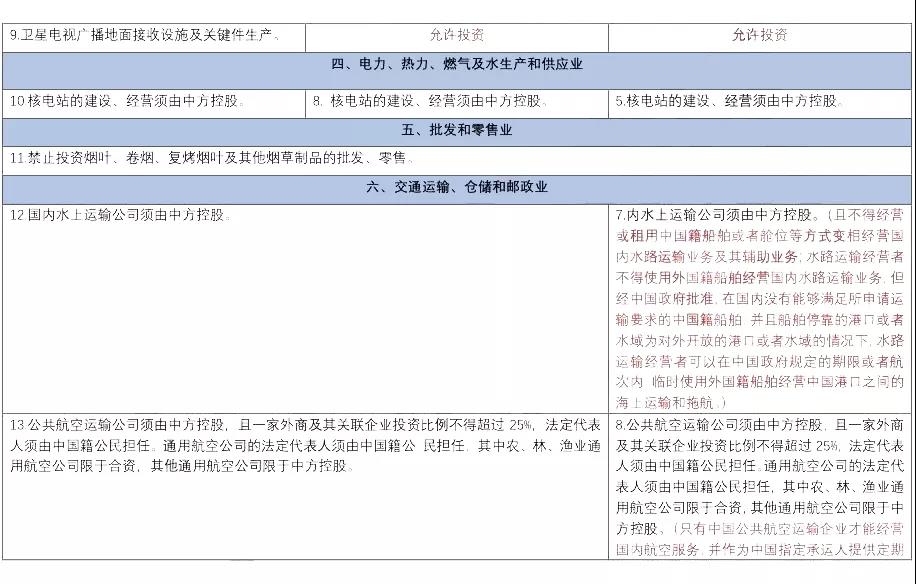主要变化
FTA进一步深化制造业开放
汽车制造领域,取消乘用车制造外资股比限制以及同一家外商可在国内建立两家及两家以下生产同类整车产品的合资企业的限制。广播电视设备制造领域,取消外商投资卫星电视广播地面接收设施及关键件生产的限制,按照内外资一致原则管理。本次修订,实现了自贸试验区负面清单制造业条目清零。
 RCEP) and the China-Cambodia FTA, both of which will come into effect on January 1, 2022.
RCEP) and the China-Cambodia FTA, both of which will come into effect on January 1, 2022. 自贸试验区探索放宽服务业准入
市场调查领域,除广播电视收听、收视调查须由中方控股外,取消外资准入限制。社会调查领域,允许外商投资社会调查,但要求中方股比不低于67%,法人代表应当具有中国国籍。 make technical conversions of certain tariff items. After the adjustment, China will have in total 8,930 tariff items.

What are the changes and which items will be affected? 在负面清单说明部分增加“从事外资准入负面清单禁止投资领域业务的境内企业到境外发行股份并上市交易的,应当经国家有关主管部门审核同意,境外投资者不得参与企业经营管理,其持股比例参照境外投资者境内证券投资管理有关规定执行”,由证监会和有关主管部门按规定对从事负面清单禁止领域业务的境内企业到境外上市融资实行精准化管理。需要说明的是,“应当经国家有关主管部门审核同意”系指审核同意境内企业赴境外上市不适用负面清单禁止性规定,而不是指审核境内企业赴境外上市的活动本身。Anti-cancer drugs and medical products: To reduce the financial burden on patients, impose zero tariffs on radium chloride injections, a new anti-cancer drug, and reduce import tariffs on some medical products, including intracranial thrombectomy stents and artificial joints.Aquatic products and sports equipment: To boost consumption upgrading and enhance the atmosphere of the winter Olympic Games, reduce import tariffs on some high-quality aquatic products, including salmon and cod, as well as baby clothes, dishwashers, and skiing gear.Oil paintings and antique artwork
 优化外资准入负面清单管理根据《外商投资法实施条例》,在负面清单说明部分增加“外商投资企业在中国境内投资,应符合外商投资准入负面清单的有关规定”。做好外资准入负面清单与市场准入负面清单衔接,在负面清单说明部分增加“境内外投资者统一适用《市场准入负面清单》的有关规定”。
优化外资准入负面清单管理根据《外商投资法实施条例》,在负面清单说明部分增加“外商投资企业在中国境内投资,应符合外商投资准入负面清单的有关规定”。做好外资准入负面清单与市场准入负面清单衔接,在负面清单说明部分增加“境内外投资者统一适用《市场准入负面清单》的有关规定”。
清单对比
Mineral resources外资准入负面清单2020年版与2021年版,及与自贸区外资准入负面清单2021年版的比较表,红色部分系最新变化:Increase import and export duties on certain commodities
From January 1, 2022, China will raise import and export duties on some commodities to balance domestic demand and supply as well as upgrade its industries. The changes include:Reimposing MFN tariffs on some amino acids, lead-acid battery parts, gelatin, pork, and m-cresol, and abolishing interim import tax rates on these products.Raising import and export duties on phosphorus and blister copper to promote the transformation, upgrading, and high-quality development of relevant industries.Further reducing MFN tariff rates on IT products 7.4 percent. Apply conventional duty rates on products from 29 countries To boost high-quality opening, China will continue applying conventional duty rates to some goods originating from 29 countries and regions, in accordance with FTAs and preferential trade arrangements agreed upon with these countries and regions.The RCEP and the China-Cambodia FTA will enter into force on January 1, 2022, which will also trigger tariff reductions.China has been implementing a series of regulations to reduce import-export taxes and duties to promote a higher level of openness and domestic consumption.The 2022 tariff adjustments reflect the country’s intention to secure its industrial and supply chains. They also aim to reallocate resources to promote technology innovation, industrial upgrades, and green development, and help boost China’s participation in the restructuring of the global industrial chains and the global free trade network.
Apply conventional duty rates on products from 29 countries To boost high-quality opening, China will continue applying conventional duty rates to some goods originating from 29 countries and regions, in accordance with FTAs and preferential trade arrangements agreed upon with these countries and regions.The RCEP and the China-Cambodia FTA will enter into force on January 1, 2022, which will also trigger tariff reductions.China has been implementing a series of regulations to reduce import-export taxes and duties to promote a higher level of openness and domestic consumption.The 2022 tariff adjustments reflect the country’s intention to secure its industrial and supply chains. They also aim to reallocate resources to promote technology innovation, industrial upgrades, and green development, and help boost China’s participation in the restructuring of the global industrial chains and the global free trade network.The 2022 tariff adjustments could affect companies that import and export taxable goods and services with China. Foreign stakeholders should pay attention to these changes to better tap into China’s growing consumer markets.

Preparing for RCEP implementation Among the 29 countries that will enjoy conventional duty rates for exports to China, nine of them – Japan, Australia, New Zealand, Brunei, Cambodia, Laos, Singapore, Thailand, and Vietnam – are among the 14 RCEP members.China will reduce tariffs on a wide range of goods imported from these nine countries starting from January 1, 2022. As a result of this latest move, more than 90 percent of the goods traded among RCEP members will be tariff-free, experts have said. This will promote the growth of regional trade and investment, according to the MOF.

 RCEP) and the China-Cambodia FTA, both of which will come into effect on January 1, 2022.
RCEP) and the China-Cambodia FTA, both of which will come into effect on January 1, 2022. 







